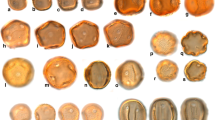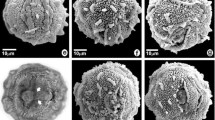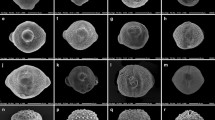Abstract
The pollen type ofPlanchonioideae is unique among the angiosperms in its syntricolpatism associated with the marginal ridge, marginal groove, and polar cushion; it has been studied byJ. Muller, who classified it into three types, mainly with a light microscope. In the present study, pollen grains of the six constitutent genera were studied with a scanning electron microscope, five additional pollen types were recognized. Of the eight pollen types the one with sealed polar ectoapertures and weakly developed marginal ridges, without marginal grooves and polar cushions is regarded as the most primitive. Evolutionary trends proceeded with the opening of the polar ectoapertures, the complication of the polar cushions and marginal grooves. In the most advanced form, the marginal ridges and marginal grooves coalesced to form two concentric rings, whereas the polar cushions were secondarily reduced.
Similar content being viewed by others
References
Barth, O. M., 1965: Elektronenmikroskopische Beobachtungen am Sporoderm der Caryocaraceen. — Grana Palynol.6: 7–25.
Carlquist, S., 1964: Pollen morphology and evolution ofSarcolaenaceae (Chlaenaceae). — Brittonia16: 231–254.
Clarke, R. T., Frederiksen, N. O., 1968: Some new sporomorphs from the Upper Tertiary of Nigeria. — Grana8: 210–223.
Cronquist, A., 1988: The evolution and classification of flowering plants. 2nd edn. — New York: New York Botanical Garden.
Erdtman, G., 1952: Pollen morphology and plant taxonomy. Angiosperms. — Stockholm: Almqvist & Wiksell.
—, 1966: Pollen morphology and plant taxonomy. Angiosperms. — New York: Hafner.
Khan, A. M., 1976: Palynology of Tertiary sediments from Papua New Guinea. I. New form genera and species from Upper Tertiary sediments. — Austral. J. Bot.24: 753–781.
Muller, J., 1972: Pollen morphological evidence for subdivision and affinities ofLecythidaceae. — Blumea20: 351–355.
—, 1973: Pollen morphology ofBarringtonia calyptrocalyx K. Sch. (Lecythidaceae). — Grana13: 29–44.
—, 1981: Fossil pollen records of extant angiosperms. —Lecythidaceae. — Bot. Rev.47: 64.
Payens, J. P. D. W., 1967: A monograph of the genusBarringtonia (Lecythidaceae). — Blumea15: 157–263.
Prance, G. T., Silva, M. F., 1973:Caryocaraceae. — Pollen. — Fl. Neotrop. Monograph12: 4–5.
Salard-Cheboldaeff, M., 1979: Palynologie Maestrichtienne et Tertiaire du Cameroun. Etude qualitative et repartition verticale des principales especes. — Rev. Palaeobot. Palynol.28: 365–388.
Takhtajan, A., 1987: Systema magnoliophytorum. — Leningrad: Nauka. (In Russian.)
Tsou, C.-H., 1990: The embryology, reproductive morphology, and systematics ofLecythidaceae. — Ph. D. of The City University of New York.
- 1993: The embryology, reproductive morphology, and systematics ofLecythidaceae. — Mem. New York Bot. Gard. (in press).
Venkatachala, B. S., Kar, R. K., 1969: Fossil pollen comparable to pollen ofBarringtonia from the Laki sediments of Kutch. — Pollen & Spores10: 335–339.
Author information
Authors and Affiliations
Rights and permissions
About this article
Cite this article
Tsou, CH. The classification and evolution of pollen types ofPlanchonioideae (Lecythidaceae). Pl Syst Evol 189, 15–27 (1994). https://doi.org/10.1007/BF00937575
Received:
Revised:
Accepted:
Issue Date:
DOI: https://doi.org/10.1007/BF00937575




